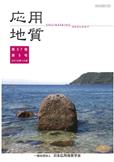
- Issue 6 Pages 257-
- Issue 5 Pages 193-
- Issue 4 Pages 154-
- Issue 3 Pages 102-
- Issue 2 Pages 58-
- Issue 1 Pages 2-
- |<
- <
- 1
- >
- >|
-
Yukiyasu FUJII, Manabu TAKAHASHI, Minoru SATO2016 Volume 57 Issue 5 Pages 193-200
Published: December 10, 2016
Released on J-STAGE: January 07, 2017
JOURNAL FREE ACCESSPolygonal cracked “Kikkou” boulders are distributed in Yakushima, southern Japan. Polygonal cracks are propagated on the surface of granitic boulders. On the section of the boulder, there is a concentric structure composed of core and crust parts. In addition, polygonal cracks are propagated from the surface to the boundary of them.
The boulders are measured by Mercury Intrusion Porosimetry(MIP), and the followings are clarified.
1:The porosity of core part is larger than that of crust part.
2:The peak pore size of core part is larger than that of crust part.
Weathered and non-weathered granitic specimens which have been sampled from outcrops and non-polygonal cracked boulders are also measured by MIP. Pore size distributions of core and crust parts in the granitic boulders are different from the ones of weathered and non-weathered granitic rocks. It is inferred that the genesis of the polygonal cracked boulders is related to alteration in boulders, from the view point of porosity structure and microscopic observations.
View full abstractDownload PDF (7761K)
-
Weiren LIN, Manabu TAKAHASHI, Daisaku SATO, En-Chao YEH, Yoshitaka HAS ...2016 Volume 57 Issue 5 Pages 201-212
Published: December 10, 2016
Released on J-STAGE: January 07, 2017
JOURNAL FREE ACCESSPore structure of rocks strongly influences permeability and other physical properties, therefore quantitative measurements of porosity and pore size distribution of rock samples are necessary and important in engineering geology. We collected total 108 rock samples of 15 rock types and measured their porosity and pore size distribution by the mercury intrusion porosimetry method and report the data and characterize the pore size distribution in this paper. Porosity and pore size distribution of rocks significantly vary with rock type, geological age and their locality. Moreover, the characteristics of pore size distribution did not show a unique correlation with the porosity of the same rock sample. Therefore, to evaluate pore size distribution of rocks is essential and useful for discussing fluid transportation related with rock pore structure. Mercury intrusion porosimetry is a useful method for pore size distribution measurements, and its reliability and repeatability were confirmed through this experimental study. For low-porosity(e.g. <1%)rocks, however, measured results of pore size distribution in large-size range(e.g. around 100μm)might have some error probably due to roughness of rock sample surfaces.
View full abstractDownload PDF (4758K) -
Ken-ichi NISHIYAMA2016 Volume 57 Issue 5 Pages 213-218
Published: December 10, 2016
Released on J-STAGE: January 07, 2017
JOURNAL FREE ACCESSChanges in rock properties and pore structure due to weathering were examined using Paleogene coarse sandstone in Amakusa Island, Kyushu, Japan. The results of the measurements are as follows:(1)according to observation of mineral texture in thin sections, matrix minerals such as calcite decrease with increasing weathering grade, while iron minerals have concentrated in matrix with increasing weathering grade,(2)effective porosity and pore volume increases with increasing weathering grade,(3)tensile strength and soil hardness decreases with increasing weathering grade.
These results suggest that increasing of pores in matrix of sandstone with increasing weathering grade is derived from leaching of calcite. Leaching of calcite and increasing pore volume plays a major role in the changes of rock texture of coarse sandstone due to weathering.
View full abstractDownload PDF (1940K)
- |<
- <
- 1
- >
- >|